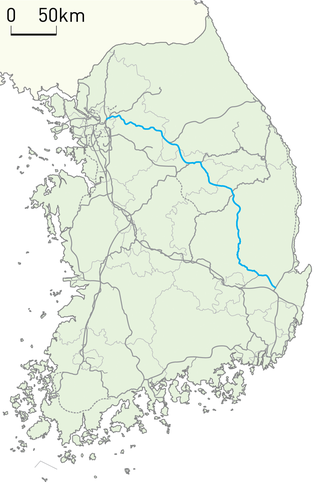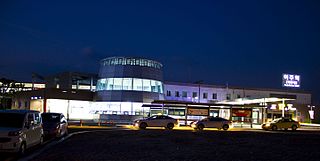
Gangwon Province, officially Gangwon State, is a Special Self-Governing Province of South Korea. It is known as the largest and least densely populated subdivision of South Korea. Gangwon is one of the three provinces in South Korea with special self-governing status, the others being Jeju Province and Jeonbuk State. Gangwon is bordered on the east by the Sea of Japan, it borders Gyeonggi Province to the west, North Gyeongsang Province and North Chungcheong Province to the south, and the Military Demarcation Line to the north, separating it from North Korea. In the 1945 division of Korea, the historical Gangwon Province was divided in half, and remains so to this day.

Pyeongchang is a county in the province of Gangwon-do, South Korea, located in the Taebaek Mountains region. It is home to several Buddhist temples, including Woljeongsa. It is about 180 km (110 mi) east southeast of Seoul, the capital of South Korea, and connected by expressways and high-speed passenger railways. Pyeongchang's slogan, "Happy 700 Pyeongchang", is taken from its average elevation of approximately 700 metres (2,300 ft).

The Jungang line is a railway line connecting Cheongnyangni in Seoul to Moryang in Gyeongju in South Korea, traversing central South Korea from the northwest to the southeast. It is also referred to as the rail line of the Seoul Metropolitan Subway from Yongsan station to Jipyeong station. The section from Cheongnyangni to Dodam was designated as a semi-high-speed railway.

Korea Train eXpress (Korean: 한국고속철도), often known as KTX, is South Korea's high-speed rail system, operated by Korail. Construction began on the high-speed line from Seoul to Busan in 1992. KTX services were launched on April 1, 2004.

Seongnam is the fourth largest city in South Korea's Gyeonggi Province after Suwon and the 10th largest city in the country. Its population is approximately one million. It consists of three administrative districts: Bundang District, Jungwon District, and Sujeong District.

The Yeongdong Expressway is an expressway in South Korea. Numbered 50, it connects the Seoul area with Gangwon Province. It is named from Yeongdong, an old name for Gangwon. The road has its western end in Namdong-gu of Incheon Metropolitan City. Its eastern end lies in Gangneung near the east coast. From Incheon to Gangneung, the expressway covers 234.39 kilometers.

The Yeongdong Line is a line of Korail. It connects Yeongju in North Gyeongsang Province with Gangneung in Gangwon Province. From Yeongju, it crosses the Taebaek Mountains and reaches the Sea of Japan at Donghae, thence proceeding north to Gangneung.

Bundang District is the largest and most populous district (gu) of Seongnam, a major city in the Seoul Capital Area, South Korea. Bundang District is one of South Korea's wealthiest and highest developed areas, being the nation's first and largest completely artificial city built in the early 1990s. Many high-rise luxury condos moved in the early 2000s, with a second planned city built in the late 2000s called Pangyo in the same district. Apartment prices are the second highest in Gyeonggi Province after Gwacheon and 7th highest nationwide, higher than many central Seoul districts such as Mapo District or Jongno District. Apartments around Pangyo station and the high-rise luxury condos around Jeongja station and Sunae station rival prices in the most expensive areas in the country. Unlike older cities such as Seoul, Bundang has no telephone poles overground, resulting in a clean cityscape with well-designed streets.

Pangyo or Pangyo New Town is a planned district composed of several dongs or neighborhoods of Seongnam, South Korea. It contains Pangyo-dong, Baekhyeon-dong, Unjung-dong, and Sampyeong-dong of Bundang District and Siheung-dong and Sasong-dong of Sujeong District (Seongnam).

Suwon Station is a railway station in the city of Suwon, South Korea. The station was completely redeveloped in 2002 and 2003, and is now integrated with the Aekyung Shopping Mall. This station serves Inter-city railway Gyeongbu Line KTX, ITX-Saemaeul and Mugunghwa will stop. Also Line 1, Suin–Bundang Line of the Seoul subway will stop. And this station is an important hub in southern Gyeonggi Province.
The Suryeo Line is a former narrow-gauge railway line owned by Korean National Railroad. The line connected Suwon to Yeoju.

Pangyo Station (Korean: 판교역) is a station on the Shinbundang Line, serving the planned city of Pangyo in the city of Seongnam. The station is close to Pangyo Techno Valley, one of the country's largest clusters of software, gaming, entertainment and biotechnology businesses, home to major tech companies like Kakao. It began operations on October 28, 2011, with the opening of the Shinbundang Line.
High-speed rail service in South Korea began with the construction of a high-speed line from Seoul to Busan in 1992, and was inspired by Japan's Shinkansen. The first commercial high-speed rail service was launched on 1 April 2004. Currently, South Korea hosts two high-speed rail operators: Korea Train eXpress (KTX) and Super Rapid Train (SRT).

Gangneung station is a railway station on the Yeongdong Line and Gangneung Line in Gyo-dong, Gangneung, Gangwon, South Korea. All Sea Trains and Mugunghwa trains stopped at this station until September 14, 2014 when it was closed because of the construction of the Gangneung Line. Because of this, all Mugunghwa trains had terminated at Jeongdongjin station.

Donghae station is a railway station in Donghae City in Gangwon Province, South Korea. Donghae station is on the Yeongdong Line, the Samcheok Line, the Mukhohang Line, and the Bukpyeong Line.

Jeongdongjin station (Korean: 정동진역) is a railway station on the Yeongdong Line of Korail, the station closest to the beach in South Korea, and a popular cross country train destination from Seoul, for sunrise viewing. It is claimed to be listed in the Guinness World Records as being the closest station and tracks to a beach anywhere in the world.

The Jungbunaeryuk Line is a rail line partly in operation and partly under construction from Bubal to Mungyeong. Construction started in November 2015. The line opened in December 2021 between Bubal on the Gyeonggang Line & Chungju on the Chungbuk Line. The KTX line was extended in 30 November 2024 from Chungju to Mungyeong. Another extension from Mungyeong to Gimcheon was approved in December 2022.

Yeoju Station is the southern terminus of the Seoul Metropolitan Subway Gyeonggang Line. It is located at 80 Gyodongno, Gyo-dong, Yeoju, Gyeonggi, South Korea.

The KTX-Eum or Korail Class 150000 is a South Korean high-speed electric multiple unit train manufactured by Hyundai Rotem and operated by Korail.


















